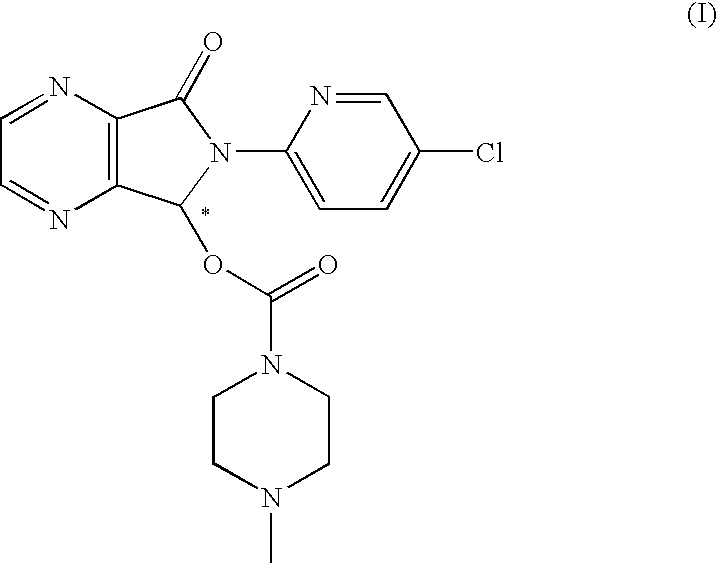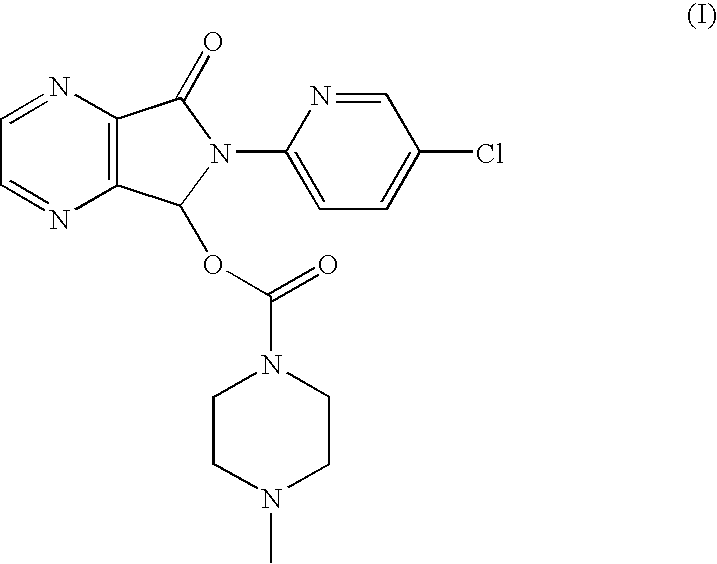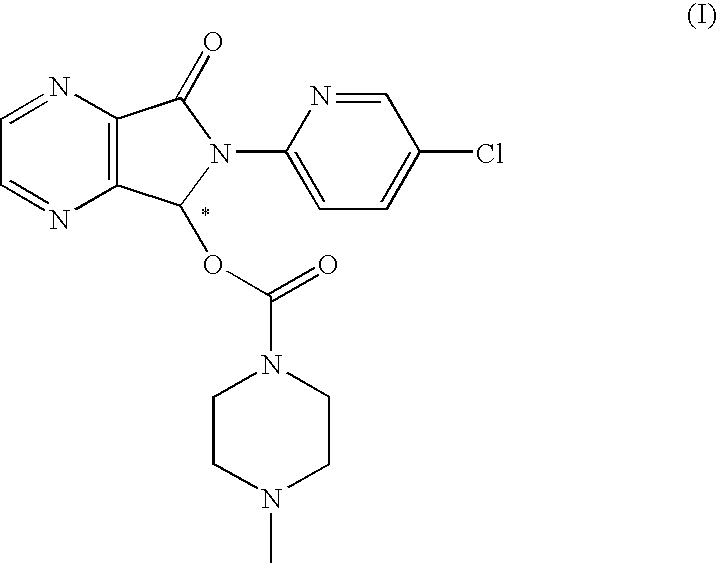Process for the resolution of zopiclone and intermediate compounds
a technology which is applied in the field of process for the resolution of zopiclone and intermediate compounds, can solve the problems of low optical purity in a single crystallization and little reproducibility
- Summary
- Abstract
- Description
- Claims
- Application Information
AI Technical Summary
Benefits of technology
Problems solved by technology
Method used
Image
Examples
example 1
Preparation of (S)-zopiclone N-acetyl-D-aspartate
[0055]A three-neck 500 ml flask was charged with 25 g of (±)-zopiclone (1 eq) and 11.3 g of N-acetyl-D-aspartic acid (1 eq). 363 ml of a mixture of methanol / toluene (1 / 1) were added. The reaction mixture was stirred for 10 minutes at room temperature, then heated and maintained for 30 minutes at reflux. The dispersion was slowly cooled and maintained for over 30 minutes at room temperature. The solid product was isolated by filtration and washed with 10 ml of methanol and 10 ml of toluene. The solid was dried under vacuum to obtain 15.6 g of (S)-zopiclone N-acetyl-D-aspartate (43%) as a white product.
[0056]Diastereoisomeric excess (d.e.): 99.5% by chiral HPLC. Water content: 0.6% w / w. Melting point: 186-189° C. [α]D20: +55° (c 1% w / w water). IR (KBr, cm−1): 3433, 1741, 1731, 1720, 1675, 1575, 1460, 1373, 1279, 1255, 1031. 1H-NMR (DMSO-d6, 400 MHz) δ (ppm): 8.96 (1H, d, 2.4 Hz), 8.93 (1H, d, 2.4 Hz), 8.53 (1H, d, 2.4 Hz), 8.36 (1H, d, ...
example 2
Preparation of (R)-zopiclone N-acetyl-D-aspartate
[0057]160 ml of a mixture of methanol / toluene at atmospheric pressure were distilled from the mother liquors of the preparation of the example 1. A light brown solid crystallized from the resulting mixture. The dispersion was cooled at room temperature. The solid was isolated by filtration and washed with 10 ml of methanol and 10 ml of toluene. The product was dried under vacuum to obtain 15.8 g of white solid (R)-zopiclone N-acetyl-D-aspartate (44%) as an off-white solid.
[0058]d.e.: 86.3% by chiral HPLC. Water content: 6.3% w / w. Melting point: 176-177° C. [α]D20: −72.5° (c 1% w / w water). IR (KBr, cm−1): 3433, 3068, 2860, 1741, 1732, 1720, 1675, 1577, 1461, 1373, 1255, 1144, 1052, 975. 1H-NMR (DMSO-d6, 400 MHz) δ (ppm): 8.96 (1H, d, 2.8 Hz), 8.93 (1H, d, 2.8 Hz), 8.52 (1H, d, 2.8 Hz), 8.36 (1H, d, 9.2 Hz), 8.10 (1H, wide signal), 8.09 (1H, dd, 9.2 Hz, 2.8 Hz), 7.76 (1H, s), 4.46-4.41 (1H, m), 3.47 (1H, wide signal), 3.31 (1H, wide sig...
example 3
Preparation of (R)-zopiclone N-acetyl-L-aspartate
[0059]A three-neck 100 ml flask was charged with 2 g of (±)-zopiclone (1 eq) and 0.9 g of N-acetyl-L-aspartic acid (1 eq), and a mixture of 29 ml of methanol / xylene (1 / 1) were added. The reaction mixture was stirred for 10 minutes at room temperature, then heated and maintained for 30 minutes at reflux, and then was cooled and the dispersion was maintained for over 30 minutes at room temperature. The solid product was isolated by filtration and washed with 0.8 ml of methanol and 0.8 ml of xylene. The product was dried under vacuum to obtain 1.18 g of (R)-zopiclone N-acetyl-L-aspartate (41%) as a white solid.
[0060]d.e.: 91.8% by chiral HPLC. Water content: 0.6% w / w. Melting point: 184-186° C. [α]D20: −57.5° (c 1% w / w water). IR (KBr, cm−1): 3413, 3060, 2964, 1732, 1720, 1661, 1467, 1376, 1258, 1169, 1079. 1H-NMR (DMSO-d6, 400 MHz) δ (ppm): 8.96 (1H, d, 2.4 Hz), 8.93 (1H, d, 2.4 Hz), 8.52 (1H, d, 2.4 Hz), 8.36 (1H, d, 9.2 Hz), 8.10 (1H,...
PUM
| Property | Measurement | Unit |
|---|---|---|
| temperature | aaaaa | aaaaa |
| temperature | aaaaa | aaaaa |
| pH | aaaaa | aaaaa |
Abstract
Description
Claims
Application Information
 Login to View More
Login to View More - R&D
- Intellectual Property
- Life Sciences
- Materials
- Tech Scout
- Unparalleled Data Quality
- Higher Quality Content
- 60% Fewer Hallucinations
Browse by: Latest US Patents, China's latest patents, Technical Efficacy Thesaurus, Application Domain, Technology Topic, Popular Technical Reports.
© 2025 PatSnap. All rights reserved.Legal|Privacy policy|Modern Slavery Act Transparency Statement|Sitemap|About US| Contact US: help@patsnap.com



